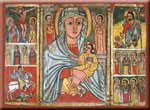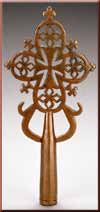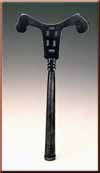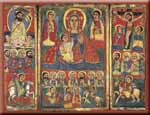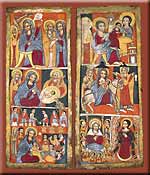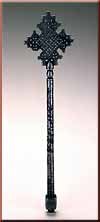
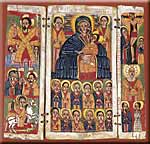
Icon
Ethiopian Orthodox style
Late 19th century
Distemper and gesso
on wood
Icon
Ethiopian Orthodox style
c. 1750-1855
Distemper and gesso
on wood
Icon
Ethiopian Orthodox style
c. 1750-1855
Distemper and gesso
on wood
Processional cross
Ethiopian Orthodox style
15th century
Copper alloy
Prayer stick finial
Ethiopian Orthodox style
Late 19th century
Iron
Faith: Curatorial Introduction and Artwork
In the fourth century, the young Syrian Christian Frumentius became an important advisor to the royal court of the Aksumite Kingdom of Ethiopia. Credited with converting the king, sponsoring Christian merchants and building churches, he was the first bishop of the Ethiopian Orthodox Church and is still venerated as Abba Salama, father of peace.
In the centuries following, the Orthodox Church was a unifying force among the regions and diverse populations in Ethiopia. Although isolated geographically, Ethiopians were conversant with and participated in discussions about Christian religious and artistic movements. The impact of a widely circulated engraving based on an icon in the Basilica of Santa Maria Maggiore in Rome on the art of Ethiopian icon painting proved particularly long lasting.
These six icons represent only a small part of a glorious religious and artistic heritage. Church patrons commissioned artist-priests to create icons in the form of single panels, diptychs and triptychs to donate to the church. It was the act of donation that was important, not personal possession. Stored with other sacred objects, icons were displayed on holy days and in public processionals. With the donors' hopes of obtaining divine intercession, images of Mary, the Mother of God, are understandably the dominant theme. Saints, both universal figures such as St. George and those of local origin such as Abba Takla Haymanot, are also prevalent. Certain icons were credited with miraculous cures.
Although the exhibition focuses on past Ethiopian icon traditions, Ethiopian icon painting is a living tradition still practiced today.
Icon
Ethiopian Orthodox style
Late 17th century
Distemper and gesso
on wood
Icon
Ethiopian Orthodox style
c. 1750-1855
Distemper, gesso and cloth
on wood
Icon
Ethiopian Orthodox style
c. 1630-1700
Distemper, gesso and cloth
on wood
Hand cross
Ethiopian Orthodox style
16th century
Iron

